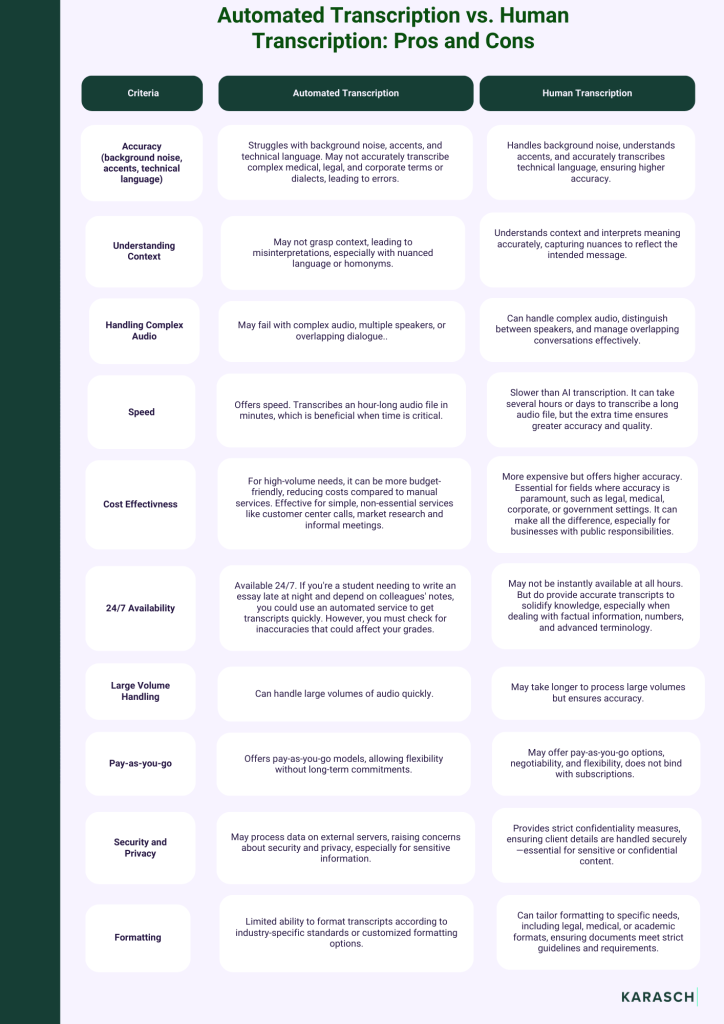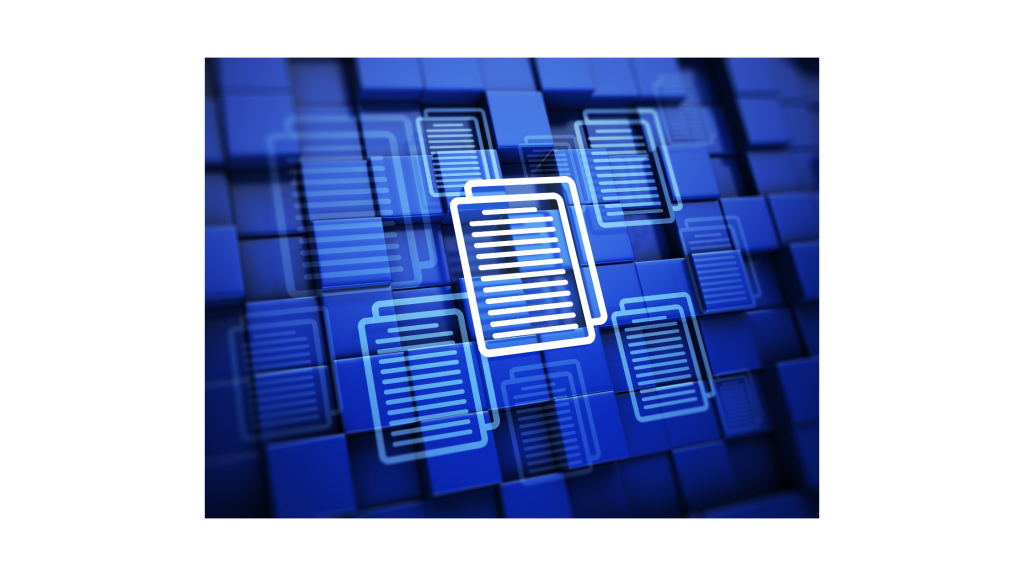Automated vs. Human Transcription: Unveiling the Differences
Discover the key differences between automated and human transcription. Take action to ensure your transcripts are accurate and meet your industry needs.
Table of Contents
Transcription Showdown: Human Expertise vs. Automated Technology
 Human transcription outperforms AI when accuracy, confidentiality, and personalization are important.
Human transcription outperforms AI when accuracy, confidentiality, and personalization are important.
Introduction
When you look at all the numerous advanced features of transcription providers, it can be hard to distinguish the benefits of human and automated transcription suitable for your needs.
Furthermore, it can be challenging to grasp the full range of transcription services or to have a clear sense of the pros and cons of transcription methods available.
It is completely normal to feel uncertain when navigating the different pricing models and options, especially if you are on a tight budget. Still, if you have to outsource many services with limited funds, it should not be to the detriment of quality.
Therefore, if you struggle to understand what exactly automated or human transcription are, and how they compete against each other, here is an explanation of the differences.
We provide an overview of the “meat and potatoes” benefits you can safely splurge on and of those that are more fancy than essential for making a well-considered choice.

Automated Transcription vs. Human Transcription: What’s Really at Stake?
Automated transcription uses AI software to turn spoken words into written text. It relies on speech recognition technology to quickly transcribe audio or video files without human involvement.
Conversely, manual transcription is when a person—usually a trained professional transcriptionist—listens to audio or video recordings and types out the spoken words into written text.
Unlike automated transcription, manual transcription is done by a human, ensuring more careful attention to detail. It is called human transcription, because an actual human does it, and not a machine.
Manual vs. Human Transcription: A Journey Through Time
Because of historical context, the terms “manual” and “human” have been used interchangeably as a matter of habit; they are not 100% identical.
Historically speaking, the quality of manual transcription has improved to welcome mechanical precision from typewriters. Next came the printing press, stenography, and audio transcriptions with dictation machines, bringing us all the way to the digital age. Now, AI software performs automated transcription and is considered “machine transcription”.
 In U.S. courts, licensed court reporters, who are highly trained stenographers, create accurate and official transcripts of legal proceedings.
In U.S. courts, licensed court reporters, who are highly trained stenographers, create accurate and official transcripts of legal proceedings.
A court reporter uses specialized shorthand or steno machines to capture every spoken word during trials, depositions, and hearings.
Note: Court reporting encompasses far more than simple stenography. It requires an understanding of legal processes and terminology, accredited by national agencies.
The precision of trained certified human stenographers and scopists (i.e. proofers) ensures there is a complete and verifiable record of what was said, which can be used for appeals, legal research, and case reviews.
Ensure your legal records, depositions, and briefings are accurate and reliable. Contact us below to see how our certified court reporters can provide the precise service you need!
Machine Transcription vs. Human Transcription
Machine-performed transcription typically outperforms manual transcribers in mechanical aspects. For example, in the past, typewriters could produce uniform fonts, unlike handwriting, which is strictly individual.
Yet, despite advancements in typing speed and accuracy with typewriters and computers, humans still beat AI with complex and nuanced thinking. The cognitive and manual transcription advantages offered by human transcribers continue to be invaluable.

While AI excels in processing data, and typewriters beat handwriting, humans understand emotions, slang, punctuation, abbreviations, acronyms, accents, and cultural context.
In addition, humans can make ethical decisions based on complex thinking processes.
Humans are also better at creative problem-solving and learning from new experiences. This makes people better suited for tasks that require empathy, abstract thinking, and judgment. In such tasks, AI will continue to fall short for years to come.

Humans can distinguish between homophones (like “their” and “there”), interpret tone and emotion, and correct unclear speech.
Human transcription also produces grammatically correct and properly formatted transcripts for specific needs, juggling with different transcript types as the needs arise.
On the other hand, AI often struggles with nuance in speech, making sense of unclear audio, and specialized jargon.
To summarize, no matter how sophisticated automated transcription software becomes, it still underperforms when it comes to:
- Accuracy resulting from challenges requiring deeper cognitive abilities.
- Key areas like emotional intelligence and field expertise.
- Critical thinking and adaptability.
Despite all the progress of AI software, automatic transcription can not achieve the 99-100% accuracy human transcriptionists can.
If you are not yet fully informed who wins in the automated vs. human transcription showdown when your business needs are in question, here is a breakdown of features in a table format:
Automated Transcription vs. Human Transcription (Table)

Are you working in a high-risk, high-stakes, and demanding field such as law, medicine or public services? Consider the following manual transcription benefits for your key areas:
Manual Transcription Benefits for Law Firms
1. Confidentiality
Law firms often handle sensitive client information, high-profile cases, financial records, details about juveniles, or trade union membership information.
Using a human transcription service you can trust keeps client details safe and private, ensuring privacy and confidentiality for all parties involved.
Let’s keep in mind an important fact that differentiates court reporting from other specialized legal transcripts:
- Law firms often use transcription services for interviews, meetings, and recorded phone conversations.
- However, they typically rely on court reporting for in-court testimonies and legal proceedings.
To guarantee confidentiality, it’s important to choose a service that understands the legal industry’s strict privacy requirements.
 In a legal setting, a human transcriptionist can make sense of similar-sounding words with opposite meanings.
In a legal setting, a human transcriptionist can make sense of similar-sounding words with opposite meanings.
Here’s why you should consider hiring a court reporting agency that also has experience in transcription services:
- Court reporting agencies are accustomed to handling sensitive information for law firms, insurance carriers, and court cases.
- They follow stringent legal protocols.
- Unlike big-box transcription agencies, combined legal transcription and court reporting providers understand the nuances and privacy concerns of legal work, off or at court.

A local or family-owned transcription company can offer personalized service and build a close relationship with your firm. Its staff are more likely to understand your specific needs and ensure confidential information is handled with great care, unlike automated systems that might store data on external servers.
Customized formatting
Legal documents such as court-ready briefs, arbitrations, or depositions typically need to follow a specific format. Manual transcription allows for this customization, ensuring that transcripts meet the required NCRA professional standards.
A human transcriber can format legal documents to follow court rules precisely, saving time and ensuring professionalism in every submission.
Reliable digital storage
Manual transcription services can offer law firms digital archiving, securely storing transcripts in an organized, searchable format. This ensures easy access to past documents, aiding in quick reference and improving efficiency.
Alternatively, when stored information needs to be deleted, a trusted and reliable local provider can help you sleep safe and sound, knowing sensitive data has not been mishandled.

Manual Transcription Benefits for Market Research
When conducting interviews, focus groups, and opinion polls in market research, transcript accuracy is vital.
Human transcription ensures that feedback is captured in text correctly. AI, on the other hand, may misinterpret multiple speakers or complex discussions.
For example, when a focus group discusses a new product, human transcribers can accurately reflect the tone and context of the speakers’ product feedback.
Ensuring that key insights aren’t lost in translation is crucial for making well-informed business decisions, running effective marketing campaigns, and improving the product in the next lifecycle.
Manual Transcription Benefits for Educational Institutions
If you are a lecturer at a university, you may well be aware of the value of clear and accurately transcribed specialized academic terminology.
Making lectures and discussions accessible to students with hearing impairments ensures the best talent gets an equal opportunity at a key life stage.
To illustrate, consider medical school lectures, notorious for their highly complex niche terminology.
Human transcription guarantees that such advanced medical terms are transcribed correctly, helping students with hearing impairments follow along without confusion.
Manual Transcription Benefits for Corporations
Corporate meetings, presentations, and interviews often involve industry jargon and sensitive information. Human transcriptionists handle these challenges more effectively than AI.
For instance, a human transcriber experienced in financial and accounting terms will accurately put on paper terms like “EBITDA“, while maintaining confidentiality. In contrast, AI might struggle with sensitive company data.

Manual Transcription Benefits for Non-Governmental Organizations (NGOs)
NGOs need reliable transcription for interviews, field research, and stakeholder meetings. Human transcription ensures that nuances in language and culture are preserved, which is critical for international projects.
If you are an NGO that works with field interviews in a rural area, your transcription needs may go beyond capturing mere words. You may want to make sure people are actually heard so that you invest your policy efforts in the right direction.
A trusted human transcription service should capture both the language and the emotions behind the words.
Learn more about Karasch Transcription Service Packages
Manual Transcription Benefits for Medical Institutions
1. Access to trained medical transcriptionists
Medical transcription needs special knowledge of medical terms, human anatomy, and clinical procedures.
If a hospital or clinic wants to ensure complex medical words are transcribed correctly, they must hire expert medical transcribers to capture the essence of often convoluted medical reports.
For example, a medical council might record audio of an exam using complicated terms like “cardiomyopathy” (a heart condition) or “esophagitis” (a throat issue).
A trained medical transcriptionist can rewind and replay audio to better understand these terms, as well as hear, comprehend, and write them accurately.

Human transcription service provides value for money when complex language is in question
Collecting feedback from the institution itself, self-correction, or using a two-step vetting process by collaborating with a colleague are three methods transcriptionists use to guarantee all the advantages of manual transcription.
Such a process doesn’t allow even the smallest mistake to slip through the cracks.
2. Keeping patient and hospital information secure
Medical institutions handle sensitive patient data that must stay private.
For instance, when transcribing patient consultations or surgery reports, the password-protected service ensures that only authorized people can access the files. This prevents data leaks and keeps patient information with enhanced caution.
3. Sticking to HIPAA rules
Medical institutions must follow HIPAA (Health Insurance Portability and Accountability Act) rules to protect patient privacy.
Avoiding legal problems is not the only reason; ensuring proper diagnostics and data-based research are additional benefits of having access to a team of seasoned medical transcriptionists.

Transcription services that comply with HIPAA make sure all processes meet federal standards for security and privacy.
If this is something a clinic needs, it can check if the transcription service is HIPAA-compliant, and uses encrypted data transfer and secure storage. This protects patient health information throughout the process.
Manual Transcription Benefits for Government Bodies
One of the standout benefits of transcription for public services is the pay-as-you-go pricing model.
Government bodies often experience fluctuating transcription needs due to changing legislative sessions, special projects, or varying workloads.
With pay-as-you-go, you can quickly cancel or access services by choice based on current projects.
For example, consider police stations and prisons. These institutions frequently require the transcription of recorded interviews with inmates, phone calls, and forensic expert testimonies.
A flexible pricing mode allows them to access and pause services on demand, based on the current workload.
Moreover, for crucial transcriptions like recorded interviews in police stations or penitentiary meetings, the accuracy provided by an experienced human transcription service ensures ticking all the boxes for legal standards and best practices.
Whether it’s a single meeting with a prison inmate or multiple public consultations at State and Federal Agencies, it is the confidentiality of human transcriptionists that is a deciding factor when choosing the best transcription provider for government bodies.
Automated vs. Human Transcription: Summary
Conclusion
When weighing the pros and cons of transcription methods, cost-effectiveness and accuracy are key factors that come to mind. For high-volume needs, automated transcription seems more cost-effective.
But consider the meaning of cost-effectiveness, which translates to “value for money”. It is not always the quickest, least expensive service that returns the required value.
In terms of speed, volume, and 24/7 availability automated transcription beats manual transcription benefits.
However, in terms of accuracy, reliability, and integrity, human-produced transcripts are the clear winner.
Therefore, reflecting on these essential questions for criteria that matter to you is a must.
Hopefully, this article that compares human and automated transcription has helped you make a better-informed decision.
Get peace of mind with accurate, court-ready transcripts!
Click below to upload your file within minutes:
Our Latest Resources
Request A
Call Back
Request A Call Back
Do you have additional questions?
Click here to meet your dedicated Client Relationship Manager.


